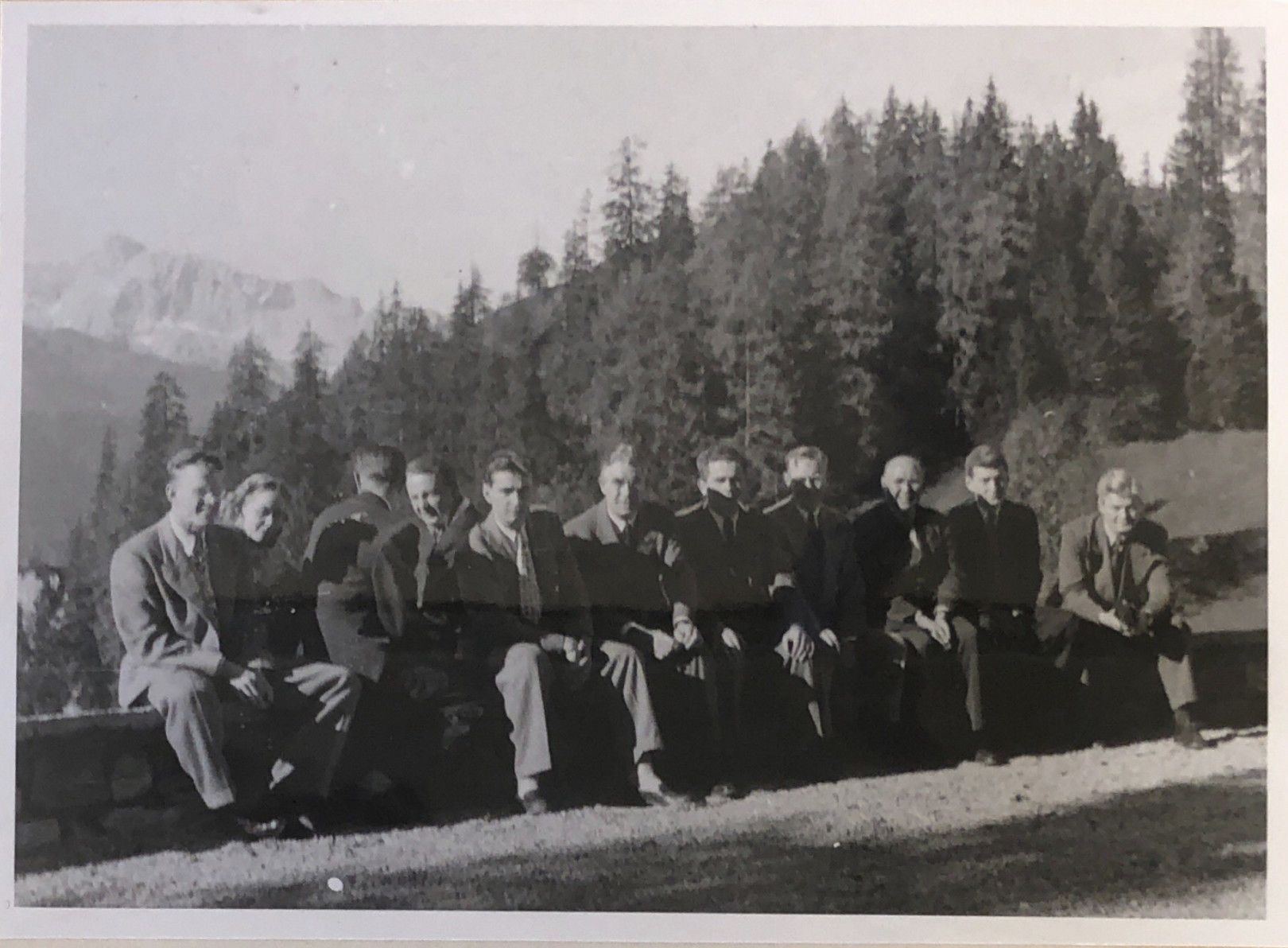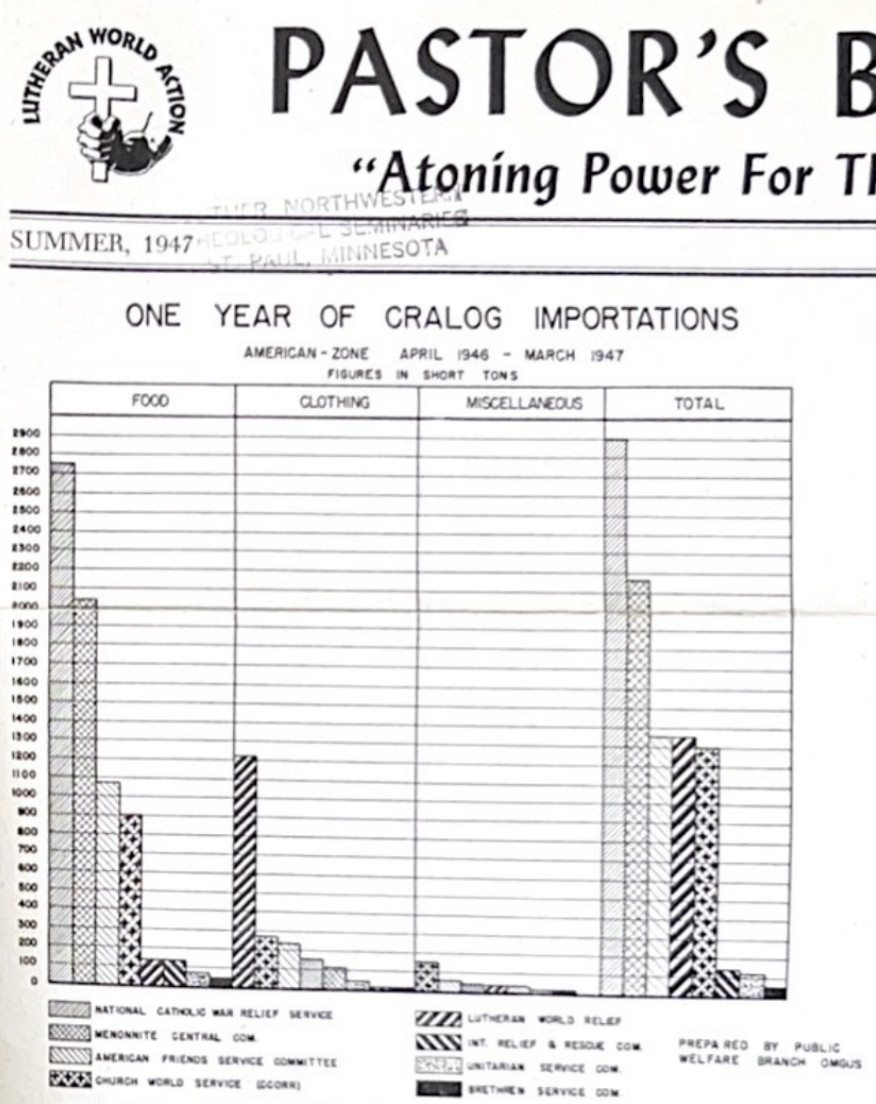International cooperation
In order for the Lutheran World Federation to provide to refugees, they had to cooperate with a wide variety of agencies, including governmental/international authorities, religious organizations, and local agencies. The pages in this section are dedicated to navigating all the abbreviations, sections, and policies that LWF and many volunteer agencies had to understand and work with. Below is a graph that illustrates the agencies directly involved with the LWF.
Government & International Authorities
Religious Organizations
Non-Religious Governmental/
International Authorities
United Nations Relief and Rehabilitation Administration (UNRRA) and International Refugee Organization (IRO)
The first and foremost for the LWF to cooperate with is the United Nations Relief and Rehabilitation Administration (UNRRA), or later its successor, the International Refugee Organization (IRO). UNRRA/IRO were responsible for supervising and facilitating the voluntary agencies to operate in Germany for aid services. The UNRRA/IRO helped the LWF to solve the logistic problems like accessing DP camps. Also, the Intergovernmental Committee on Refugees (IGC) provided financial support for UNRRA.
Supreme Headquarters of the Allied Expeditionary Forces in Europe (SHAEF)
SHAEF was the headquarters for all Allied Forces in Europe in 1944-1945. For the liberation of Europe, the military authorities established Assembly Centers (ACs) in barracks of the German army, warehouses, bombed buildings, and concentration camps. The DPs were gathered in more than 900 crowded ACs. Under an agreement with UNRRA in 1944, SHAEF was responsible for collecting and providing housing, food, clothing, and medical supplies, while UNRRA would administer the DP camps, provide recreational facilities, health and welfare services and other support.
National Non-Religious Agencies
Displaced Persons Commission
The Displaced Persons Commission was established to supervise the DP program in the United States and cooperate with the voluntary agencies.
Council of Relief Agencies Licensed for Operation in Germany
The U.S. VAs (voluntary agencies) co-founded a non-governmental Organization, called the “Council of Relief Agencies Licensed for Operation in Germany” (CRALOG). The LWF was a licensed CRALOG member in order to operate in Germany. But, before CRALOG, a number of federal officials and private voluntary agencies created the American Council of Voluntary Agencies for Foreign Service (ACVAFS) that provided means of consultation, coordination, and planning so that relief and reconstruction programs abroad may be carried on in the most effective way. To become part of CRALOG, one had to be a member agency of the ACVAFS.
International/National Religious Organizations
International Christian Organizations
Out of the international Christian organizations of the time, the World Council of Churches (WCC), the Church World Service (CWS) and the Young Men Christian Association (YMCA) stood out as having prominent roles. To learn more about their work be sure to click on the button to the right!
American Lutheran Organizations
The American Christian Committee for Refugees (ACCR) was established under Truman Directive. They provided corporate affidavits and helped in case of individual affidavits, selected persons for sponsorship, interviewed the applicants for emigration and answered questions regarding emigration. Altogether, the ACCR had sponsored 768 affidavits and 194 individual affidavits for non-Jews/Catholics to the US and Latin America countries. It transferred all its cases to the Church World Service (CWS) and liquidated in July 1947 due to lack of finance and inefficiency and lack of support.
According to the 1948 DP Act, the resettlement of a DP should include secured assurances, promises of jobs and housing. To fulfill this requirement, LWF worked with the National Lutheran Council (NLC) and was also sometimes financed by the Lutheran World Action (LWA). The NLC received the DP dossiers created by the LWF and started to match the DP with a sponsored family and job. It then became the local church’s responsibility to call for the sponsorship from the local families and the local commissions helping with the resettlement. In terms of Northfield, Minnesota, where much of our scope lies, these groups were St. John’s Lutheran Church and the Committee for the Resettlement of Displaced Persons in Northfield.
Jewish-American Organizations
American aid to Jewish displaced persons began quickly after the end of the World War II. After World War II, President Franklin Delano Roosevelt established the War Refugee Board to help rescue Jewish displaced persons.1 When UNRRA established the DP camps, most Americans were not aware of the difficult situation the DPs were living under until the Harrison Report and when General Eisenhower offered his own witness of the conditions of the camps. The result was the Truman Directive that admitted 23,000 DPs to the U.S., most of whom were Jewish.2
However, the American Jewish society aimed at admitting more of the Jewish DPs to the U.S.. Thus, the Jewish organizations, such as American Jewish Joint Distribution Committee (JDC), American Jewish Committee (AJC), and Hebrew Immigrant Aid Society (HIAS), started calling for more attention on the DP issues among other religious groups, such as the Christian community.
American Jewish Joint Distribution Committee (JDC)
JDC was the first American relief agency in the field, spending $317,000 in 1945 in Germany and Austria.
JDC asked to go into Germany and Austria before the victory, but receiving resistance from the army, they did not make it. The permission to operate in Europe was given to them finally on June 16, 1945 to dispatch 10 teams to DP camps.
JDC provided religious, recreational and educational supplies to DPs alongside supplements to UNRRA/IRO and army supplies.
When IRO initially started, they could not provide enough aid. JDC was the major relief agency that provided major aid to the DPs during this time.
American Catholic Organizations
The American Catholics stepped into the post-war relief rather later, after Jewish congregations called upon the other religious groups to aid in DP resettlement and support.
The War Relief Services (WRS) was formed in 1943 by the Bishop’s Committee of the National Catholic Welfare Conference (NCWC) to carry out the overseas relief work for Catholic refugees in 41 countries for DPs after the war. It mainly provided morale services, supplies for spiritual, recreational or occupational nature, and supplementary materials such as food, clothing, and shoes.
NCWC cooperated closely with American Lutherans in the resettlement of Volksdeutsche/Ethnic Germans, as half of the German Expellees were Catholic.
Local German Agencies
The LWF had to work with the local German agencies for the distribution of supplies and knowledge. The American Church Voluntary Agency representatives, for one, established a German Central Committee (GCC) to help receive the welfare supplies and find areas that needed the most distribution. They also worked with the local German Hilfswerk, which was established by the bishops of the various Landeskirches of Germany at the bishop’s conference at Treyaa in 1945. Hilfswerk, working closely with CRALOG, often assisted the inland transportation of the supplies.3
For the rest of DPs who were not able to immigrate, the German government prepared plans to assimilate the handicapped DPs in the German economy. The Lutheran Churches in Germany, in cooperation with LWFSR, presented plans to IRO and the German government to help those for whom institutional care would be a necessity. The Lutheran Inner Mission Societies assumed this responsibility on behalf of the Lutheran Churches in Germany.4
The majority of the information on this page was found from Haim Genizi’s book America’s Fair Share.6
Endnotes
1.United States Holocaust Memorial Museum, “WAR REFUGEE BOARD: BACKGROUND AND ESTABLISHMENT,” Holocaust Encyclopedia, accessed July 25, 2023, https://encyclopedia.ushmm.org/content/en/article/war-refugee-board-background-and-establishment.
2. United States Holocaust Memorial Museum, “WAR REFUGEE BOARD: BACKGROUND AND ESTABLISHMENT,” Holocaust Encyclopedia, accessed July 25, 2023, https://encyclopedia.ushmm.org/content/en/article/war-refugee-board-background-and-establishment.
3. Kenneth C. Senft, “The Lutheran World Federation and the Displaced Person” (PhD diss., Lutheran Theological Seminary, 1952), found in Kierkegaard Library Rare Books Room.
4. Kenneth C. Senft, “The Lutheran World Federation and the Displaced Person” (PhD diss., Lutheran Theological Seminary, 1952), found in Kierkegaard Library Rare Books Room.
5.Haim Genizi, “7. The Displaced Persons Commission and the Resettlement of MPs,” chapter, in America’s Fair Share: The Admission and Resettlement of Displaced Persons, 1945-1952 (Detroit, MI: Wayne State University Press, 1994).
6. Haim Genizi, “7. The Displaced Persons Commission and the Resettlement of MPs,” chapter, in America’s Fair Share: The Admission and Resettlement of Displaced Persons, 1945-1952 (Detroit, MI: Wayne State University Press, 1994).
Click the button below to view the complete bibliography for this digital exhibition.
Photo Credits
(from Top to bottom, left to right)
1. Two men discussing, Lutheran World Federation Service to Refugees 1947-1949 Photographic Section, used with permission of the Lutheran World Federation and Evangelical Lutheran Church in America.
2. Xiaoyang Hu, List of levels – Agencies/Organizations that related to LWF-SR (agencies/organizations in direct contact are flagged.)
3. Two people leaning over a typewriter, Lutheran World Federation Service to Refugees 1947-1949 Photographic Section, used with permission of the Lutheran World Federation and Evangelical Lutheran Church in America.
4. Group of people sitting, Lutheran World Federation Service to Refugees 1947-1949 Album, used with permission of the Lutheran World Federation and Evangelical Lutheran Church in America
5. Pastor’s Bulletin graph, Evangelical Lutheran Church in America (ELCA) Region 3 Archives, Luther Seminary St. Paul, MN.
*Description ordering is based on computer view. If viewing this page on a smartphone or tablet, please check the descriptions provided as the ordering may be distorted.


